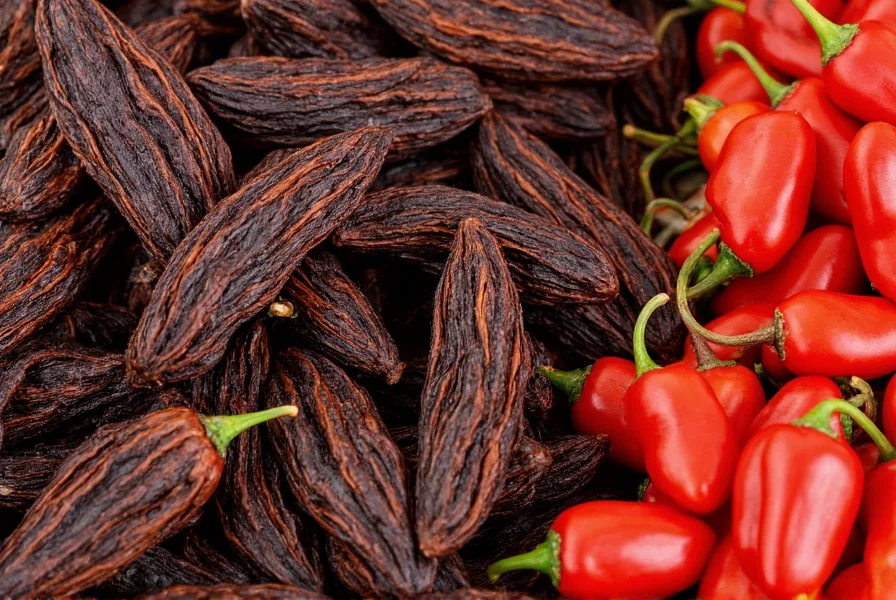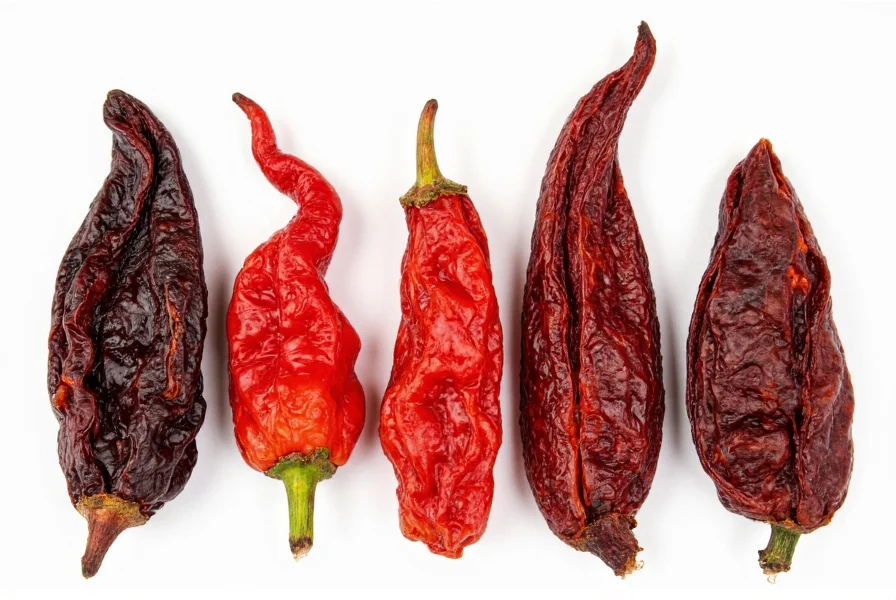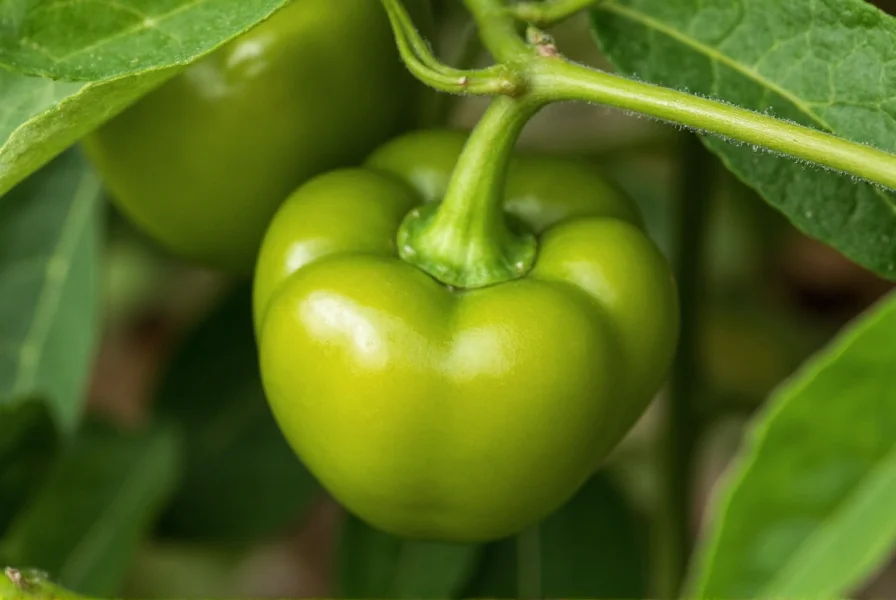The pasilla pepper, known as "little raisin" in Spanish due to its wrinkled appearance and sweet, fruity flavor, is one of Mexico's most essential dried chilies. Despite common confusion in American markets, authentic pasilla peppers originate from the fresh chilaca pepper, not the poblano as many believe. This distinction matters significantly for authentic Mexican cooking where specific pepper characteristics affect dish authenticity.
Physical Characteristics and Identification
True pasilla peppers measure 6-8 inches long with a slender, tapered shape that wrinkles considerably when dried. Fresh chilaca peppers (which become pasillas when dried) start as glossy dark green and mature to a rich brownish-black. The dried form features a distinctive raisin-like appearance with deep wrinkles and a mahogany to nearly black color.
| Characteristic | True Pasilla (Dried Chilaca) | Common Misidentification (Dried Poblano) |
|---|---|---|
| Origin Pepper | Chilaca | Poblano |
| Shape | Long, slender, tapered (6-8 inches) | Broad, heart-shaped (3-5 inches) |
| Color (Dried) | Deep brown to black | Dark reddish-brown |
| Flavor Profile | Fruity, berry-like, mild tobacco notes | Earthy, slightly sweet, more vegetal |
| Heat Level (Scoville) | 1,000-2,500 SHU | 1,000-2,000 SHU |
Flavor Profile and Heat Level
Pasilla peppers offer a complex flavor profile that distinguishes them from other dried chilies. They deliver a mild to medium heat (1,000-2,500 Scoville Heat Units) with pronounced fruity notes reminiscent of berries and raisins, complemented by earthy undertones and subtle hints of cocoa and tobacco. This nuanced flavor makes them indispensable in traditional Mexican mole sauces, where they contribute depth without overwhelming heat.
Understanding pasilla pepper heat level is essential for recipe success. While significantly milder than jalapeños (2,500-8,000 SHU), pasillas provide more complexity than bell peppers (0 SHU). Their moderate heat allows their distinctive flavor to shine through in dishes rather than simply providing spiciness.
Origin and Common Naming Confusion
The confusion surrounding pasilla peppers stems from inconsistent labeling practices, particularly in the United States. In Mexico, the term "pasilla" exclusively refers to dried chilaca peppers. However, many American grocers and even some cookbooks incorrectly label dried poblanos as "pasillas," while calling the actual pasilla "pasilla de Oaxaca" or similar terms.
This misidentification creates challenges for home cooks seeking authentic flavors. When exploring pasilla pepper vs poblano differences, remember that true pasillas come from chilaca peppers and have a longer, thinner shape compared to the broader, heart-shaped poblanos. This distinction becomes critical when following traditional recipes that specify pasilla for its unique flavor contribution.
Culinary Applications and Traditional Uses
Chefs value pasilla peppers for their versatility in Mexican cuisine. They're fundamental ingredients in:
- Mole negro and other complex mole sauces
- Adobo marinades and sauces
- Salsas de molcajete (mortar-and-pestle salsas)
- Stews and braises requiring deep, complex flavors
- Mojo sauces for meats and vegetables
Professional cooks typically toast dried pasillas lightly before rehydrating them in hot water for 15-20 minutes. This process enhances their natural flavors and makes them easier to blend into smooth sauces. The rehydrated peppers can then be pureed and incorporated into various dishes, providing both flavor and a rich, dark color.

Finding Authentic Pasilla Peppers
Locating genuine pasilla peppers requires some knowledge due to the widespread mislabeling. When searching where to buy pasilla peppers, consider these options:
- Mexican specialty markets (most reliable source for authentic product)
- Online retailers specializing in authentic Mexican ingredients
- Some larger grocery chains in the international foods section
- Grow your own chilaca peppers if you have gardening space
When selecting pasilla peppers, look for deeply wrinkled, uniformly dark specimens with a rich, slightly sweet aroma. Avoid peppers with excessive moisture, mold, or pale spots, which indicate age or improper storage. Properly stored in an airtight container in a cool, dark place, dried pasillas maintain quality for 6-12 months.
Effective Substitutes When Pasillas Are Unavailable
If you're searching for a pasilla pepper substitute, several options can approximate its flavor profile depending on your recipe's requirements:
- Ancho peppers (dried poblanos) - closest substitute though slightly sweeter and less fruity
- Mulato peppers - similar earthiness with chocolate notes, slightly hotter
- Guajillo peppers - brighter fruitiness, higher acidity, medium heat
- Combination approach - mix ancho (for sweetness) with a small amount of chipotle (for smokiness)
Understanding pasilla chile pepper characteristics helps determine the best substitute. For mole sauces, a combination of ancho and mulato often works best, while guajillo may suffice for salsas where acidity plays a supporting role.

Practical Tips for Cooking with Pasilla Peppers
Maximize your success with pasilla peppers using these professional techniques:
- Always remove seeds and veins before rehydrating to control heat level
- Toast lightly in a dry skillet for 30-60 seconds per side to enhance flavor complexity
- Rehydrate in broth instead of water to add additional flavor dimensions
- Strain and reserve rehydration liquid to incorporate into sauces for extra depth
- Blend thoroughly for smooth sauces, passing through a fine mesh sieve if necessary
When incorporating pasilla peppers into fresh applications (using fresh chilaca peppers), note that they're less common in American markets than their dried form. Fresh chilacas work well in salsas verdes, roasted vegetable dishes, and as a milder alternative to serranos in fresh preparations.











 浙公网安备
33010002000092号
浙公网安备
33010002000092号 浙B2-20120091-4
浙B2-20120091-4